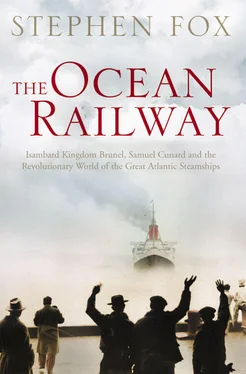Most of the early British engineers, both civil and mechanical, came from Scotland and northern England. Telford and Rennie were Scotsmen who learned their crafts in Edinburgh, then migrated south to find work. Henry Maudslay, a noted steam engine builder and inventor of machine tools, was from a Lancashire family outside Liverpool. He grew up in his father’s carpentry shop but preferred working with iron, so he switched to blacksmithing. Wielding his hammer, file and chisel, he was a true artist, deft and inventive, utterly in his element. He moved to London and opened a workshop that became famous for its marine steam engines and general excellence. James Nasmyth, one of his many apprentices who went on to notable engineering careers, fondly recalled his first impression of Maudslay’s shop at Lambeth in 1829: ‘ the beautiful machinetools, the silent smooth whirl of the machinery, the active movements of the men, the excellent quality of the work in progress, and the admirable order and management that pervaded the whole establishment.’ Maudslay stressed simplicity and economy to his assistants, demonstrating the lesson by turning a rough piece of metal into a smooth, plane surface with just a few precise strokes of his file.
Civil and mechanical engineers jointly created their most significant early achievement, the steam railway. Mining operations had already produced the first small steam locomotives and had demonstrated the unmatchable rolling efficiency of iron wheels on iron tracks. Because the earliest railway locomotives lacked much pulling or braking power, the right-of-way had to avoid steep hills; that meant borrowing from the canal builders’ levelling techniques for tunnels, viaducts, embankments and cuttings. Mail coaches and coastal steamboat lines had shown the advantages of providing public transportation on set timetables at fixed fees. All these separate strands came together in tracks and trains. Because the Industrial Revolution had arrived so early in Britain, it happened there long before the railway – a sequence not repeated anywhere else. The iron horse then exploded on a society already well industrialized, quickly transforming everyday life in ways that steam-powered mines, mills and factories had not touched.
George Stephenson, the seminal British railway pioneer, was an illiterate engine mechanic born near Newcastle. He always spoke with a thick Northumbrian accent barely intelligible to southerners. After a delayed education, Stephenson built the initial two railways in England, the Stockton and Darlington (1825) and the Liverpool and Manchester (1830), designing the locomotives and rolling stock as well as laying down the track and its associated structures. The Liverpool and Manchester, the first line to run between major cities, was expected mainly to carry freight such as coal, cotton and timber between the port on the Mersey and the booming inland factory city. But passengers came forth in surprising numbers, so Stephenson started offering them fast trains on a regular schedule.
What the customers were buying was speed, achieved with a smoothness and consistency previously unknown. It seemed extraordinary that a businessman could leave Liverpool in the morning, travel thirty-three miles and spend his long workday in Manchester, and still return home by that night in reasonable fettle. A mail coach might average only about ten quite jostling miles an hour. A fast horse and rider at full gallop could reach up to forty miles an hour, but only in brief spurts, and with an exhausting clatter and commotion. Railway engines would match a galloping horse and maintain that speed serenely for hours, chuffing along in a steady rhythm with no apparent strain.
In the summer of 1830, the actress Fanny Kemble – fresh from her first great triumphs on the London stage – took an excited ride on a Liverpool and Manchester locomotive, with Stephenson himself driving. She felt inclined to pat the small iron horse, which consisted of just a boiler, stove, engine and gleaming steel pistons, a platform, bench, coals and a barrel of water. ‘How strange it seemed,’ she noted, ‘to be journeying on thus, without any visible cause of progress other than the magical machine, with its flying white breath and rhythmical, unvarying pace.’ No horse, no sail; how did it move? They glided easily through cuttings, across bridges and a viaduct, along raised embankments, and over a swamp. Stephenson described the construction of his locomotive, which Kemble thought she understood (‘His way of explaining himself is peculiar, but very striking’). After taking on more water, he let out the throttle, pushing the engine to a giddy thirty-five miles an hour. Sensing the dramatic moment, Kemble stood up, took off her bonnet, and drank it in. The onrushing air pushed against her, forcing her eyelids down. It felt like flying, so fast and yet so smooth and free. ‘When I closed my eyes this sensation of flying was quite delightful, and strange beyond description; yet, strange as it was, I had a perfect sense of security, and not the slightest fear.’
Fanny Kemble’s joyful initiation into railbound flight symbolized a turning point in material history. The triumphs of engineering now hooked the nineteenth century on an ongoing expectation of constant, unsatisfied acceleration: speed and progress, reaching into every area of life, ever faster, and regardless of the dangers. ‘ Verily is oursthe age for invention,’ said the Illustrated London News in 1842. It was in many ways a Faustian contract, balanced uncertainly between gains and losses. Critics of modernity such as Thomas Carlyle, John Ruskin and William Morris played a steady minor-keyed threnody in the background as Victorian progress boomed inexorably along. A few dissenting engineersdid express timid misgivings about such headlong haste, and about the harrowing, infernal landscape of the Black Country of coal and iron mines in the industrial Midlands. But most practitioners, civils and mechanicals alike, shrugged off such criticisms. ‘ If we wouldcredit these imbecile philosophers, the introduction of every machine is an injury rather than a benefit,’ one engineer bristled. ‘There can be no greater fallacy than this.’
Most engineers apparently believed their work would improve humankind – lightening its labour, speeding and easing travel, making life more comfortable and abundant. In any case, they devoted themselves to engineering for the more basic reason that they so enjoyed their craft. Engineers worked very hard, to the point in many cases of wearing themselves out at a premature age. R. A. Buchanan, the eminent historian of Victorian engineering, has suggested that they toiled such long hours mainly because they preferred it to any other possible activity. They didn’t socialize much, avoided religious and political strifes, and lived simply and quietly. In 1838 a young railway engineer, Daniel Gooch, made an expected appearance at a dinner party thrown by his boss’s family – but quickly escaped. ‘ I believeI did succeed in getting as far as the staircase,’ he scolded himself in his diary, ‘and left it disgusted with London parties, making a note in my memorandum-book never to go to another.’
Nestled into their workshops, pondering some engineering puzzle of agreeable difficulty, they found their truest happiness in making up a brand-new world. Henry Maudslay took obvious, extravagant pleasure in manipulating his tools, loving the work for its own sake as much as for its applied uses. It called on all the keenest faculties of mind, eye and hand. To plan their projects, engineers made careful drawings and crafted detailed models. ‘ Drawing isthe Education of the Eye. It is more interesting than words,’ James Nasmyth insisted. ‘The language of the tongue is often used to disguise our thoughts, whereas the language of the pencil is clear and explicit.’ Fondling their raw materials on a workbench, shaping and pounding and drilling, the engineers absorbed cues and knowledge directly through their fingertips. Inspiration flowed from the head and eyes out through the hands to the work, and then back again, in a seamless, tactile circuit of material creation. At their peaks, they felt the exultation of artists.
Читать дальше












